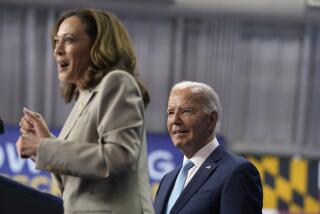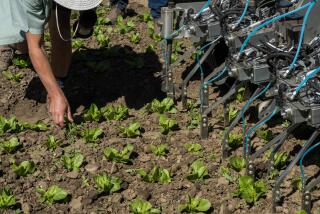Rising food prices may start with seeds
For 40 years, farmer Todd Leake and his family have battled bitter cold, hungry pests and a short growing season to coax soybeans out of their fields in eastern North Dakota.
The one thing they never had to fight for, though, was their seeds.
FOR THE RECORD:
Seed prices: An article Friday in Section A about the federal government examining whether certain practices in agriculture were driving food prices higher said officials were seeking to determine whether there were antitrust practices that violated federal laws. The practices should have been described as anti-competitive or monopolistic. —
A decade ago, salesmen from as many as 50 seed companies would compete for their dollars. Each would promise healthier plants, richer yields or a better discount.
Today the Leakes have little choice: There are four seed companies in their area, and all sell seeds that include genetic traits patented and licensed by Monsanto Co., the world’s largest seed firm.
“There’s basically nothing else available,” said Leake, 48. “You have to use their seeds and pay their prices.”
The concerns of farmers such as Leake will take center stage in Ankeny, Iowa, on Friday as the Justice Department and U.S. Department of Agriculture kick off the first of a yearlong series of public meetings to examine whether antitrust practices in agriculture are driving food prices higher.
The meetings are intended to allow producers, competitors and activists to air their concerns about the grain, poultry, dairy and livestock industries. The government is also trying to ferret out reasons for the sometimes vast gaps between what farmers are paid for producing food and the prices shoppers pay at the grocery store.
Justice Department officials, who spoke on background because they said it was too early to comment about concerns raised at the meetings, said the workshops were a chance for the government to examine the changes the food sector had undergone in recent years.
The push to hold such events, the officials said, was driven in part by President Obama’s concerns over how consolidation has affected industry competition.
Many experts believe that rising food prices start with seeds.
In recent years, the companies that develop seeds for farmers to sow in their fields have consolidated. Complaints about unfair competitive practices by the few giant firms left have soared. As a result, critics say, the effects of more costly seeds have rippled out to the nation’s dining tables.
The farm community -- which produces more than $80 billion annually in soybeans and corn -- has been pressuring lawmakers to investigate why it’s costing them so much more to grow their crops. U.S. farmers spent about $17 billion on seeds last year, up 56% from 2006, the USDA said.
Yet over the last decade, the number of independent seed companies in the U.S. has shrunk to fewer than 100 from more than 300, said Bill Wenzel, national director of the nonprofit Farmer to Farmer Campaign on Genetic Engineering, a network of 34 farm groups.
Today, four companies account for 50% of the world’s proprietary seeds for major crops. The leader is Monsanto Co., whose marketing practices the Justice Department is investigating.
“There’s a growing sentiment in this White House administration that competition, and the lack of it, is getting to be a serious problem in the food sector,” said Neil E. Harl, an Iowa farmer and a retired Iowa State University economics professor. “The question will be whether the government will, after these hearings, take a more active approach.”
By anyone’s standard, Monsanto is huge, as is its influence on consumers: Ninety-two percent of the U.S. soybean acres and 85% of the fields planted with corn are grown with seeds that use Monsanto technology, according to a 2009 report issued by Farmer to Farmer.
Crops grown with Monsanto’s patented genes probably contributed to the pancakes served at breakfast, the hamburger eaten at lunch and the fruit punch poured at dinner.
The federal government has company in its scrutiny of Monsanto. At least three state attorneys general have begun probes into whether the St. Louis company has abused its market dominance to undermine rivals and raise prices.
The company also is embroiled in a sweeping legal fight with rival DuPont Co. and its subsidiary Pioneer Hi-Bred International, which has claimed that Monsanto violated antitrust laws by using its gene licenses to quash competition.
Monsanto insists that it has done nothing wrong.
“Monsanto believes an objective review of the agricultural sector will reveal that competition is alive and flourishing,” it said in a statement this week. A Monsanto executive is expected to speak in Iowa on Friday.
About 75% of processed food -- such as margarine and chicken soup -- on the country’s grocery shelves contains engineered ingredients. These include soybeans that have been genetically modified to be more resistant to pests and weeds.
It was the lowly soybean that was the first staple crop to be successfully engineered and widely planted, thanks to Monsanto.
In an effort to bolster sales of its herbicide glyphosate, or Roundup, Monsanto turned to its laboratories to create crops that would tolerate the weed-killer. Instead of trying to alter soy’s genes, they layered on new ones.
As a result, the Roundup Ready soybean seed and its patented traits were born and hit the market in 1996. Sales skyrocketed.
So did a new business model, in which farmers aren’t buying a 50-pound bag of seeds but paying for a license of Monsanto’s biotechnology patents and the right to use those patents for one production year. The price tag can also include additional costs, such as a technology fee.
Now, with the patent on the Roundup Ready soybean expiring in 2014, along with the company’s ability to draw royalties, Monsanto is pushing farmers to switch to its second generation of Roundup Ready seeds.
Farmers such as Leake say they have little choice but to go along.
“I ran out of conventional seeds in 2004,” Leake said. “I had to shift over to seeds with Monsanto’s genes.”
He said he’s also paying more. In 2000, a bag with enough Roundup Ready soybean seeds to fill 1 acre of land would have cost him $17. Now, he said, he pays as much as $50.
He and his neighbors tried to figure out why the cost of seeds has jumped when they visited a Monsanto demonstration field last summer.
“Someone asked, ‘Why are they priced so high?’ ” Leake recalled. “They told us, ‘The price of soybeans has gone up and our company believes we are deserving of higher seed prices because of the extra traits we’re giving the farmer.’ ”
“What can you do?” Leake asked. “There’s really no alternative.”
p.j.huffstutter@
latimes.com
More to Read
Sign up for Essential California
The most important California stories and recommendations in your inbox every morning.
You may occasionally receive promotional content from the Los Angeles Times.










